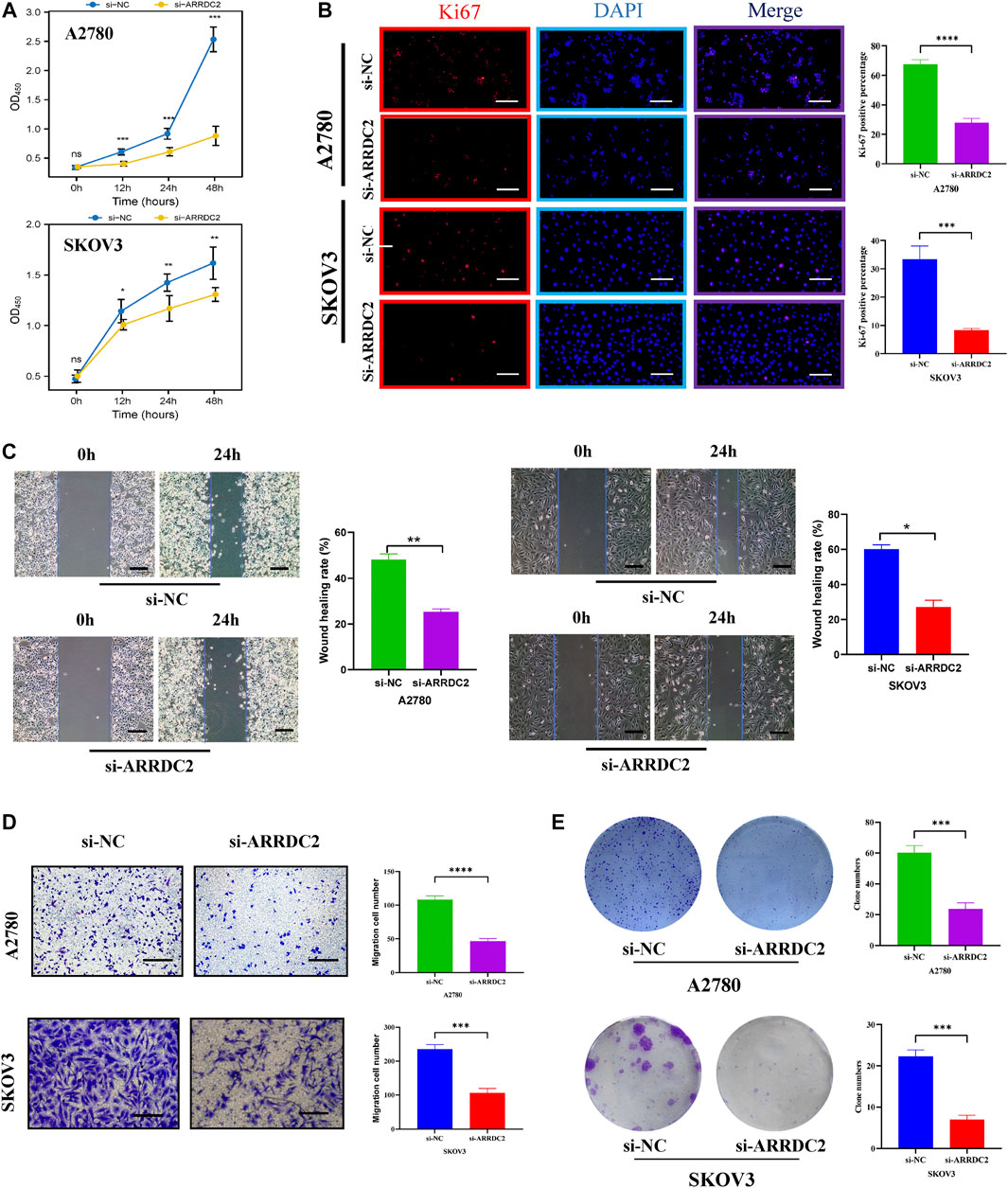A Potential Indicator ARRDC2 Has Feasibility to Evaluate Prognosis and Immune Microenvironment in Ovarian Cancer
- 1Department of Gynecology, Harbin Medical University Cancer Hospital, Harbin, China
- 2Department of Gynecology, Beijing Shijitan Hospital, Capital Medical University, Beijing, China
A Corrigendum on
A potential indicator ARRDC2 has feasibility to evaluate prognosis and immune microenvironment in ovarian cancer
by Zhang M, Liu Y, Liu Y, Hou S, Li H, Ma Y, Wang C and Chen X (2022). Front. Genet. 13:815082. doi: 10.3389/fgene.2022.815082
In the published article, there was an error in Figure 9 as published. Figure 9C in the published article showed the results of wound healing assays in ovarian cancer cell lines A2780 and SKOV3 after knockdown of ARRDC2. There was an error in Figure 9C in the published article, the image of wound healing in the ovarian cancer cell line SKOV3 at 0 h after knockdown of ARRDC2 was wrong. The corrected Figure 9 and its caption appear below.

FIGURE 9. Effects of ARRDC2 gene knockdown on malignant biological behavior of OC cells. (A) CCK8 experiment results of A2780 and SKOV3 cell lines after cell transfection. The OD values measured at 450 nm wavelength at 0, 12, 24, and 48 h were displayed, which represented the cell proliferation rate. (B) Ki-67 immunofluorescence staining of A2780 and SKOV3 cell lines after cell transfection. (C) Wound-healing assay results and statistics of OC cells after cell transfection. The wound-healing rate was measured at 0 and 24 h. (D) Transwell assay results and statistics of OC cells after cell transfection. The number of migrating cells was measured at 24 h, which represented the ability to migrate. (E) The results and statistics of cell clone formation assay of A2780 and SKOV3 cell lines after cell transfection (*p < 0.05, **p < 0.01, ***p < 0.001, ****p < 0.0001).
The authors apologize for this error and state that this does not change the scientific conclusions of the article in any way. The original article has been updated.
Publisher’s note
All claims expressed in this article are solely those of the authors and do not necessarily represent those of their affiliated organizations, or those of the publisher, the editors, and the reviewers. Any product that may be evaluated in this article, or claim that may be made by its manufacturer, is not guaranteed or endorsed by the publisher.
Keywords: arrestin domain containing 2, biomarker, immunity, prognosis, ovarian cancer
Citation: Zhang M, Liu Y, Liu Y, Hou S, Li H, Ma Y, Wang C and Chen X (2022) Corrigendum: A potential indicator ARRDC2 has feasibility to evaluate prognosis and immune microenvironment in ovarian cancer. Front. Genet. 13:978493. doi: 10.3389/fgene.2022.978493
Received: 26 June 2022; Accepted: 25 July 2022;
Published: 24 August 2022.
Edited and reviewed by:
Jared C. Roach, Institute for Systems Biology (ISB), United StatesCopyright © 2022 Zhang, Liu, Liu, Hou, Li, Ma, Wang and Chen. This is an open-access article distributed under the terms of the Creative Commons Attribution License (CC BY). The use, distribution or reproduction in other forums is permitted, provided the original author(s) and the copyright owner(s) are credited and that the original publication in this journal is cited, in accordance with accepted academic practice. No use, distribution or reproduction is permitted which does not comply with these terms.
*Correspondence: Xiuwei Chen, MTQyN0BocmJtdS5lZHUuY24=
 Mengjun Zhang1
Mengjun Zhang1 Xiuwei Chen
Xiuwei Chen